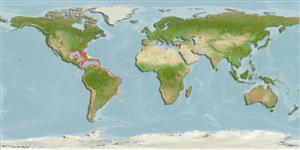Common names from other countries
>
Anguilliformes (Eels and morays) >
Congridae (Conger and garden eels) > Congrinae
Etymology: Conger: Latin, conger = conger (Ref. 45335).
More on author: Poey.
Environment: milieu / climate zone / depth range / distribution range
Ökologie
seewasser riff-verbunden; tiefenbereich 120 - 400 m (Ref. 57911). Tropical
Western Central Atlantic: Cuba and Jamaica (Ref. 3715); probably throughout northern South America (Ref. 5217). Cosmopolitan in tropical and subtropical waters.
Size / Gewicht / Alter
Maturity: Lm ? range ? - ? cm
Max length : 160 cm TL Männchen/unbestimmt; (Ref. 3715); common length : 90.0 cm TL Männchen/unbestimmt; (Ref. 5217)
A benthic species (Ref. 26340) found in rocky areas or coral reefs (Ref. 5217). Feeds on fishes. Marketed fresh and salted.
Life cycle and mating behavior
Maturities | Fortpflanzung | Spawnings | Egg(s) | Fecundities | Larven
Randall, J.E. and R. Vergara R., 1978. Congridae. In W. Fischer (ed.) FAO species identification sheets for fishery purposes. Western Central Atlantic (Fishing Area 31). Vol. 2. pag.var. (Ref. 3715)
IUCN Rote Liste Status (Ref. 130435)
CITES (Ref. 128078)
Not Evaluated
Bedrohung für Menschen
Harmless
Nutzung durch Menschen
Fischereien: weniger kommerziell
Tools
Zusatzinformationen
Download XML
Internet Quellen
Estimates based on models
Preferred temperature (Ref.
115969): 13.1 - 22.4, mean 17.9 (based on 79 cells).
Phylogenetic diversity index (Ref.
82804): PD
50 = 0.5000 [Uniqueness, from 0.5 = low to 2.0 = high].
Bayesian length-weight: a=0.00048 (0.00021 - 0.00110), b=3.23 (3.05 - 3.41), in cm Total Length, based on LWR estimates for this Genus-body shape (Ref.
93245).
Trophic level (Ref.
69278): 4.5 ±0.80 se; based on food items.
Widerstandsfähigkeit (Ref.
120179): sehr niedrig, Verdopplung der Population dauert mehr als 14 Jahre. (Preliminary K or Fecundity.).
Fishing Vulnerability (Ref.
59153): Very high vulnerability (90 of 100).
